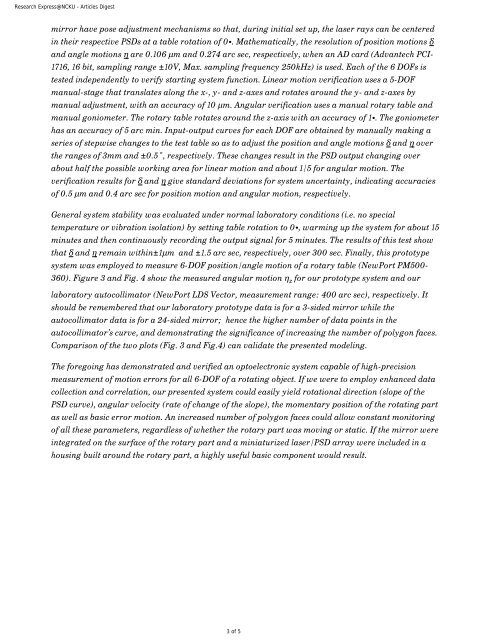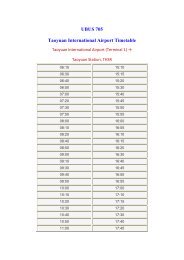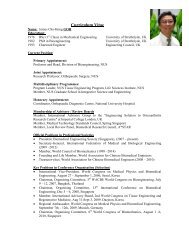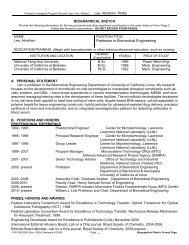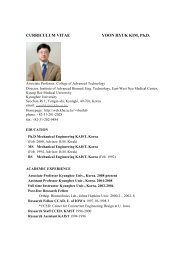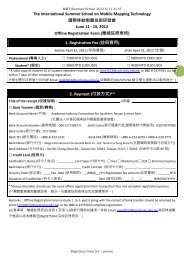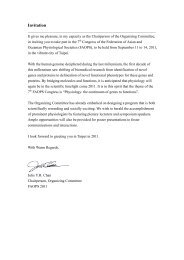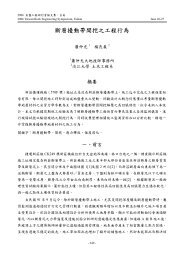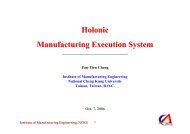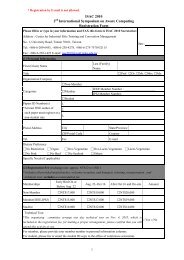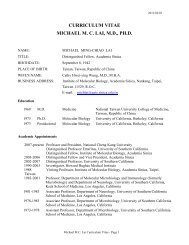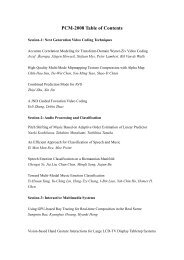Research Express@NCKU - Articles Digest
Research Express@NCKU - Articles Digest
Research Express@NCKU - Articles Digest
You also want an ePaper? Increase the reach of your titles
YUMPU automatically turns print PDFs into web optimized ePapers that Google loves.
<strong>Research</strong> <strong>Express@NCKU</strong> - <strong>Articles</strong> <strong>Digest</strong>mirror have pose adjustment mechanisms so that, during initial set up, the laser rays can be centeredin their respective PSDs at a table rotation of 0•. Mathematically, the resolution of position motions δand angle motions η are 0.106 μm and 0.274 arc sec, respectively, when an AD card (Advantech PCI-1716, 16 bit, sampling range ±10V, Max. sampling frequency 250kHz) is used. Each of the 6 DOFs istested independently to verify starting system function. Linear motion verification uses a 5-DOFmanual-stage that translates along the x-, y- and z-axes and rotates around the y- and z-axes bymanual adjustment, with an accuracy of 10 μm. Angular verification uses a manual rotary table andmanual goniometer. The rotary table rotates around the z-axis with an accuracy of 1•. The goniometerhas an accuracy of 5 arc min. Input-output curves for each DOF are obtained by manually making aseries of stepwise changes to the test table so as to adjust the position and angle motions δ and η overthe ranges of 3mm and ±0.5˚, respectively. These changes result in the PSD output changing overabout half the possible working area for linear motion and about 1/5 for angular motion. Theverification results for δ and η give standard deviations for system uncertainty, indicating accuraciesof 0.5 μm and 0.4 arc sec for position motion and angular motion, respectively.General system stability was evaluated under normal laboratory conditions (i.e. no specialtemperature or vibration isolation) by setting table rotation to 0•, warming up the system for about 15minutes and then continuously recording the output signal for 5 minutes. The results of this test showthat δ and η remain within±1μm and ±1.5 arc sec, respectively, over 300 sec. Finally, this prototypesystem was employed to measure 6-DOF position/angle motion of a rotary table (NewPort PM500-360). Figure 3 and Fig. 4 show the measured angular motion η z for our prototype system and ourlaboratory autocollimator (NewPort LDS Vector, measurement range: 400 arc sec), respectively. Itshould be remembered that our laboratory prototype data is for a 3-sided mirror while theautocollimator data is for a 24-sided mirror; hence the higher number of data points in theautocollimator’s curve, and demonstrating the significance of increasing the number of polygon faces.Comparison of the two plots (Fig. 3 and Fig.4) can validate the presented modeling.The foregoing has demonstrated and verified an optoelectronic system capable of high-precisionmeasurement of motion errors for all 6-DOF of a rotating object. If we were to employ enhanced datacollection and correlation, our presented system could easily yield rotational direction (slope of thePSD curve), angular velocity (rate of change of the slope), the momentary position of the rotating partas well as basic error motion. An increased number of polygon faces could allow constant monitoringof all these parameters, regardless of whether the rotary part was moving or static. If the mirror wereintegrated on the surface of the rotary part and a miniaturized laser/PSD array were included in ahousing built around the rotary part, a highly useful basic component would result.3 of 5


